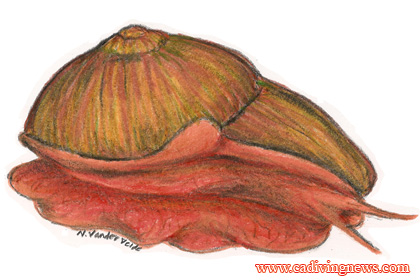How many seashells do you know? A thousand? A couple hundred? Maybe only a few dozen? Worldwide, it is estimated that there are tens of thousands of species of seashells, and likely there is no one on earth who could really claim know them all.
But of the hundreds, dozens, or whatever number of the seashells that you figure you know, how many of those could you locate in their natural habitat? If you are like most people, probably less than whatever number you know.
And of those you could locate, do you know their complete names – including their scientific names and common names? Maybe not too well. But there are two seashells which inhabit the coastal waters of Southern California that are delightfully easy to know, easy to find and especially easy to know by name. These are Norris’ Top Snail (Norrisia norrisi) and Kellet’s Whelk (Kelletia kelletii).
While these two seashells are both gastropods (snails) and inhabit kelp forest areas, they are not related all that much to each other biologically and ecologically.
They belong to two different orders – Archaeogastropoda for the top snail (along with other favorites such as abalones and limpets), and Neogastropoda for the whelk (and other popular collectibles, such as murexes, olives shells and volutes).
Kellet’s Whelk prefers life on the bottom, often prowling about rocks and gravel, looking for dead or injured sea creatures on which to dine. Norris’ Top Snail likes to reach for the rather lofty, swinging sites on the blades, bladders and stipes of brown kelps such as the Giant Bladder Kelp (Macrocystis pyrifera) and the Feather Boa Kelp (Egregia laevigata) – at least during the night. In the day, it tends to retreat to the lower parts of the plants, but by the time midnight approaches, it will have moved up to the top – although, at any time, it may loose its grip and tumble below. It feeds on the seaweed on which it dwells.
Kellet’s Whelk is big and tall, up to seven inches in length (one of the biggest snail shells commonly found along the California shore), with an attractive sculptured spire, but admittedly a rather drab gray color. Norris’ Top shell is bright amber-gold to chestnut brown hued, but is short and squat, only reaching about an inch in height and two inches across. Algae may cover the outside of the shells of both and the bodies of both snails are brighter than their shells.
From time immemorial, both shells have been popular finds among beachgoers. The shell of Norris’ Top retains its bright color even after the animal has died and is often washed ashore in the beach rubble. People have been known to eat the meat of Kellet’s Whelk and its large shell seems to have also been used as a trumpet in early California. Larger, subtidal hermit crabs will utilize any empty Kellet’s shell they may find.
But what really brings these two shells together, besides their propensity of ending up in one person’s casual shell collection, is the fact is that they were named after somewhat obscure historic personages.
Both of those whose appellations the snails bear were nineteenth century Englishmen. Henry Kellett was a sea captain who was involved in various coastal surveys, and in investigating Pacific and Arctic waters. He did sail the waters off of California – whether or not he got to know the sea snail which eventually bore his name (albeit in a slightly misspelled manner) is unclear. Thomas Norris was a surgeon and avid collector of shells and insects. He eventually amassed an extensive assortment of seashells, said to be one of England’s largest private collections, at least at his time and hence would have undoubtedly appreciated the honor of his name being attached to such an outstanding shell.
And attached, not just once, but three times, as also came to be the case with Kellett – the common name, generic name and specific name. It is unlikely that anyone nowadays will be able to have his or her name memorialized to the same triple extent. But all can at least draw satisfaction from being able to know and easily remember two common and attractive California seashells.










